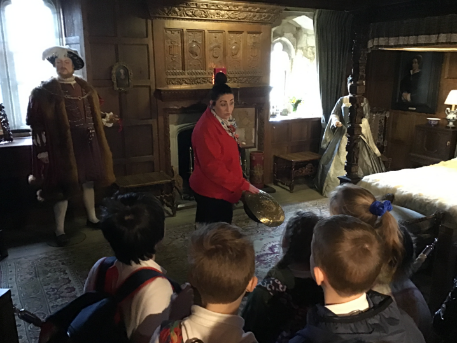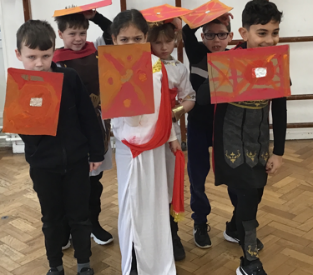History
“A people without knowledge of their past history, origin and culture, is like a tree without roots.”
Marcus Garvey - political activist
Why history is important to us?
We think history is crucial for children today because it helps them understand how people lived in the past, how things change over time, the different kinds of societies that have existed and how different groups of people relate to and have interacted with each other. Our two big ideas – diversity and culture – feature frequently in history lessons. For example, in Year 3, children learn about the daily lives of Anglo-Saxons and in Year 6, pupils discover the forgotten history of Black people in Britain.

History from all around the world in our curriculum.
How does the curriculum structure support our aims?
Our approach to history learning from Reception into Years 1 and 2 aims firstly to help the children develop a solid awareness of the past and an understanding of the concept of chronology, by looking at changes within living memory and also significant events and people from history. In Years 3 and 4, we spend two years focusing on British history to ensure the children develop a secure understanding of the history of these islands as a coherent, chronological narrative from the Stone Age to the end of the Tudor period. In Year 5, we learn about three ancient civilisations: the Egyptians, the Greeks and Early Islamic. In Year 6, the children embark upon an in-depth local study of World War Two and carry out a thematic unit called Black and British, which spans the Roman period to the modern day.

How do we make history real and meaningful for our children?
We aim to bring history to life in our lessons. This means that our teachers are skilled in telling the story of each period, helping our pupils to feel what it must have been like to live during these different times. Wherever it is possible and relevant, we make links between the historical periods we are studying and our local area – for example, in the units on castles in Year 1, the Tudors in Year 4 and World War Two in Year 6.

How do we develop historical skills?
All our units of study begin with a big question, which overarches all lessons. We come back to this frequently and often finish with a composite task, which brings the children’s learning together to answer the big question. A key aspect of our history teaching is our use of a chronological overview and our timelines. These are consistent and progressive throughout the school and are designed to be large enough to be interrogated by the children. They also use colour coding to help pupil understanding of abstract concepts like BC and AD. We find that these timelines are a very effective means for the children to see their learning from past years and help them make connections between different periods they have studied. Vocabulary teaching is a critical element of good history teaching at Woodlands; we choose the words we want pupils to learn in each lesson and teach these discretely. Reading is a feature of all history lessons. We regularly ask children to read and analyse a range of primary and secondary sources to develop their critical thinking skills. We also have a keen appreciation for developing pupils’ disciplinary knowledge and we ensure this is considered fully by mapping out a progression for teaching second order historical concepts to pupils (these include, Cause and Consequence, Continuity and Change, Similarity and Difference, Significance and Using Evidence).
How do we use assessment in history?
Assessment is used in history in a variety of ways. In all lessons, we create meaningful tasks for the children to complete, provide feedback on these, ask thought-provoking questions, facilitate opportunities for in-depth discussion and help the children activate and connect prior knowledge to new learning. If we discover important gaps in learning, we may decide to remodel the learning or task, use visuals or an analogy to explain a concept, provide additional scaffolding or update future planning. Assessment is also used as a learning tool in lessons through multiple-choice quizzes and timeline tasks, when children are required to retrieve previously taught content, helping its transfer to their long-term memories. During and after learning, we check if the children have learnt what we want them to by their responses in composite tasks, low stakes quizzes and other retrieval activities. Teachers bring all this knowledge formed over the course of the year to make an overall judgement as to whether each pupil is working at the expected level for history or not; this is reported to parents. Our year group leads and history subject lead will also conduct pupil voice sessions and scrutinise pupils’ book to ascertain how well vocabulary and knowledge has been retained and demonstrated over time. Having triangulated monitoring, the history subject lead may decide to update planning, support teachers with planning or pedagogy, involve the Inclusion team if issues pertain to pupils with SEND, review curriculum sequencing or possibly review the effectiveness of the retrieval activities used.
How do we promote inclusivity and challenge in history?
It is important that all our pupils access and learn effectively in our history lessons across the school. This involves us setting suitable learning challenges, responding to pupils’ diverse needs and overcoming potential barriers to learning and assessment for individuals and groups. Teachers utilise a range of adaptive strategies to meet the needs of our pupils, which work well in all subjects. In addition to this, we utilise further adaptations specific to history, which support pupils with SEND. For example, we use practical activities to spark the interest of children and allow them to explore these first-hand e.g. looking at primary sources including artefacts, newspapers and photographs. Providing visual representations of the past is a crucial part of all our lessons. Using pictures and images wherever possible helps enormously and for many pupils it is their main way into subject. Repetition and reinforcement is an important way for us to help pupils with SEND retain key concepts in the long term. Our use of consistent, colour-coded timelines across the school is an example of this. In order to challenge our pupils in history, we aim to set the expectation high for all pupils and provide scaffolding for those who need it in order to access the learning. More specifically, we have a range of strategies which require a significant intellectual challenge throughout all our units. This includes analysing statistical information e.g. looking at the role of the Soviet Union in bringing an end to World War Two; expressing a viewpoint e.g. answering the question ‘Were the Dark Ages really that dark?’; setting conundrums and problem-solving e.g. working out who the grave at Sutton Hoo might have belonged to.

